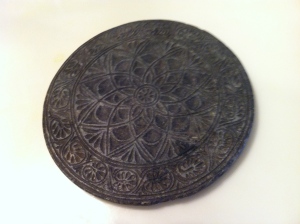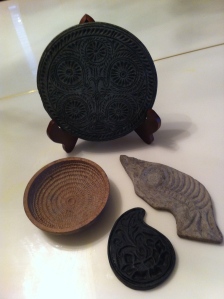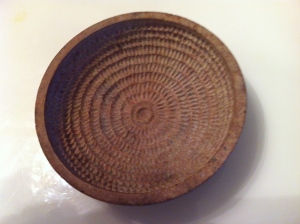


Cooking With A Flair
Welcome to my Kitchen where I write, draw, sing, and cook at the same time! I am going to share my family’s (who were originally from East Bengal, currently known as Bangladesh), and my own simplified creative cooking recipes with you. After Partition of India in 1947, my family moved to West Bengal which is situated in the Eastern part of India, so it is basically Indian cooking with a regional flavour, a little different from what we usually find in the restaurants. The ingredients are local, fresh, and healthy. My grandmother came from an artistically talented family who were proud of their scrumptious cooking recipes.
In those days, women learned the basic skills to run a family - cooking, sewing, knitting - and also many of them used their artistic abilities of drawing, painting, even carving on stones. Cooking was one of those everyday and essential activities, but also a vehicle of their imagination and creativity! My grandmother belonged to a family in East Bengal, who had a huge area of land, and they used to entertain many local and foreign guests with fresh ingredients grown in their own land with their famous culinary extravaganza.
Definitely the crops and vegetables came from their own land, fish came from their own ponds, or local rivers. Her later life was not the same because of the political situations and after partition of India, the family migrated to a city in India, but she passed on those skills and recipes to her daughters, daughter-in-laws, and grandchildren like me. While trying each and every of those mouth-watering recipes, I feel close to those women whose talents were not appreciated and keep saying to myself, "My grandmother was the best chef - no one like her!''.
After living in different regions of India, Middle East and North America for a long time, my cooking is not purely Bengali, or Indian, any longer. The core is Bengali, influenced by the Middle eastern; philosophy is North American - keep it simple and fast!. In modern life we have to. But that's how I like it, and my family and friends like it. I get inspired by glamorous chefs like Michael Smith, Laura Calder, Jamie Oliver or Lynn Crawford, and learn tips and techniques, but in my kitchen I am the queen, I create my own recipes by giving an international twist to my grandmother's.
Bengali (Indian) Kitchen In 1970's
The memory of the kitchen in the house I lived in as a child is not very glamorous. The house was a huge house with three floors, a big terrace, backyard, a garden with fountains, enormous roof, and a garage. In those days, I guess, in every country, the kitchen was the most neglected part of the house, or at least not a show-off part of the house.
The main kitchen was far from the other rooms, in the back part of the main house, completely separated from other rooms. Those were only a few bare rooms - I remember one being used for vegetarian food, and the other for non-vegetarian. Those rooms did not have any sink, or running water. The water was supplied from the tube-well next to it. Those rooms used to be unbearably hot, because of the coal-burning stoves in each of them.
The women used to spend hours and hours in those rooms, cutting vegetables, cleaning fish and meat, grinding spices, and preparing delicious meals for the whole family. In the mornings, starting at six o'clock, my mother and grandmother used to spend hours in those unventilated cubicles; in the afternoons, they had some hired help. Usually families used to hire people to help with cleaning, cutting, and grinding, but the main cooking part used to be done by the women in the family.
I have to admit, as a young girl I was not interested in cooking at all, because I dreaded those blazing, fiery stoves, and did not want to go close to it! Originally those rooms were meant to be used by people who were hired, so no luxury was needed, but our family was not wealthy after they left their ancestral house in East Bengal, and migrated to India, so my mother and grandmother spent the long mornings and afternoons in those unbearably hot rooms.
Cooking is so much fun, but definitely in the right environment, with right utensils, and right people to serve. I have a well-ventilated, well-lighted, spacious, nice kitchen with quite a few gadgets, but my most precious gadgets are a slow-cooker, and a digital pressure cooker. In India, I have seen almost every family using a pressure cooker, perhaps to save energy. In North America, ovens and barbecues are used more than a pressure cooker.
In Bengali kitchens, except one or usually two of those big coal-burning stoves, they had a few “Hari” which is a giant pan with a lid, usually made of aluminium for daily use; copper, or brass for occasional use. The rice and dal (lentils) were boiled and cooked in those “Haris”. The water was drained out with the help of the lid for the rice. Dal is a soup kind of liquid dish, thin or thick, depending on the variety of lentils. Bengalis used to have their dal less spicier than other gravy or curry dishes. Here comes a special technique they use to make dal flavourful, but not spicy. This technique is called Phoran” or Sambhar, a term which means “ Flavour”.
This is in fact, adding a bunch of whole spices to hot oil, and mixing that to the dal or curry in the beginning or end as finishing up. A lot of flavour does really happen by using this little but unique technique. Other than “ Hari”, we had “Karai”- an open, flat pan, usually made of cast-iron, or steel. A karai is used for stir-frying, deep-frying and cooking all the vegetables, fish, and meat. Non-stick was not known, so the Karai and the oil have to be heated really well before you fry a vegetable, or a fish. Bengali kitchens were equipped with a few Haris of different sizes, and a few Karais of different sizes, too. Different shapes and sizes of spoons were also used to stir, fry, scoop, or blend.
The dishes we used to have our food on, were usually made of brass, and later stainless steel. Occasionally on weddings, special guests were served on silver dishes. The glasses for drinking water were also made of brass. Later we started using glass, china and stainless steel . Tea-cups were made of china. In South of India, they use shiny steel for all their pots and pans, dishes and tumblers, and even cups for drinking tea. Stainless steel is easy to clean, so convenient for daily use. In Bengal people use silverware for very special occasions, such as, Mukhebhat (First Rice Ceremony) for babies, or weddings. Silverware is a gift for those occasions, too.
A really interesting concept was using banana leaves or "Kalapata" for serving food during festivals, weddings and celebrations. In India, parties are big! It's like a communal gathering. For a wedding, everybody - close and distant relatives, friends and friends of friends, neighbours, whoever lives close by - anyone we have the chance to talk to once in a while - will be invited for the party and the food. Sometimes the party continues for a few days. So, banana leaves are the easiest way of serving food to hundreds of people; at present, traditions are being ignored in favour of new trends. So, plastic dishes and cutlery are taking place like they had been in the west.
One special item from the Bengali kitchen must be mentioned. They are the moulds for sweets and desserts. My grandmother used to carve those moulds from stone; a few of her moulds were made of cement, or clay and baked in a coal-oven. In our family, we still have some of those moulds hand-carved by my grandmother, and some of those prized possessions are proudly exhibited in my living-room cabinet. The cover of this blog will show some pictures of those artistic creations and we realize how laboriously and precisely they were carved.
The Journey Begins
Indian cooking and aromatic spices are just inseparable. Every region in India has a distinct flavour to their cooking - North and South, East and West - they all have their own favourite spices contributing to the flavour, the aroma, the fragrance, the taste of their signature dishes - doesn't matter if it is a a humble everyday dish, or a unique dish reserved for special occasions. In the western world, understanding of Indian food is often limited to Butter Chicken, Tandoori Chicken, Paneer Makhani, or Biriyani. Those recipes are enjoyed for sure, but all of those four dishes are influenced by the cuisine from North India. One can find rarely a South Indian restaurant in North America allowing westerners to sample South Indian food. Dosa, Idli, Uttapam are a few examples of South Indian cuisine, hugely popular at home and abroad. Most people are likely not aware of the fact that a significant number of Indians are vegetarian.
As a result Indian cuisine has a lot to offer in the way of vegetarian dishes alongside their non-vegetarian menu. I am not a vegetarian, Bengalis are usually not. We eat a lot of fish. However, some of the vegetarian dishes are so delicious that sometimes I feel, and a lot of people may agree with me, we could live our lives without eating meat. No worries, I am not asking anyone to be a vegetarian; Bengal has great fish and meat dishes to die for!
If you are planning to plunge into the adventure of trying your cooking hand at Bengali cuisine, to begin with, you need to prepare your kitchen with at least five to ten basic spices which make Bengali cooking so flavourful and appetizing. All the spices are available in regular grocery stores as well as speciality stores, and people tend to pick the powdered ones, because they are ready and easy to use.
As a little girl, I woke up every morning to the grinding sound of a "Shilnora" a mortar and pestle (it was a flat rectangular stone with another heavy round-ended stone as a tool for grinding), and the irresistible aroma of the freshly ground spices - Turmeric, Chillies, Ginger, Mustard - coming from the very simple kitchen. Oh, how much I miss that smell! A big part of my childhood was waking up every morning wondering what would be the special dish of the day!
The job was not easy; whoever had this task of grinding the spices, constantly found themselves exercising their hands and arms, grinding onions and chillies to the point that would make anyone cry . All the spices would have to be ready before the cooking started, even before the fresh ingredients such as fish, meat and vegetables arrived from the market, because those were the basic spices needed for almost every item on the menu. It was almost like a ritual!
For my family's everyday cooking, we used to have five or six spices to begin with - Turmeric and Chilli Powder, Cumin, Coriander, Mustard seeds, together with onions, ginger and garlic. My own pantry today is stocked with the same spices. And I will always have onions, ginger and garlic too, in freshly chopped, grated or in blended form. Today I don't use the grinding stone, Instead, I use a mixer-blender for wet grinding and a small coffee-grinder for dry. I was able to get hold of a mortar and pestle from an Indian store ( I think I have seen one in " Kitchen Plus" too!), but it serves mainly as a decoration piece in my kitchen cabinet. Don't get me wrong, I have seen famous chefs really (Is it Jamie Oliver?) using it. Let me tell you something while we are on the subject of freshly ground or blended spices.
My suggestion is - don't try grinding Turmeric roots as they would be too hard for a coffee-grinder to handle. Get the powdered ones from grocery stores. The colour is so vibrant and some brands will even have the authentic smell to it as freshly ground from Turmeric roots! I get whole cumin, coriander, and fennel seeds, and dry-roast them and keep them in a tightly-sealed jar. Whenever I need to add the spices, I take a handful and grind them in my dry coffee-grinder. Such a fresh flavour!
New Vocabulary related to Indian Kitchen:
Hari - a deep-bottomed vessel with a lid, usually used for boiling rice or dal
Dal - lentil-soup
Karai - a shallow pan for stir-frying, or deep-frying
Kala Pata - Banana leaves for serving food
Shil-nora - a flat rectangular stone and a round one for grinding wet spices
To Be Continued....